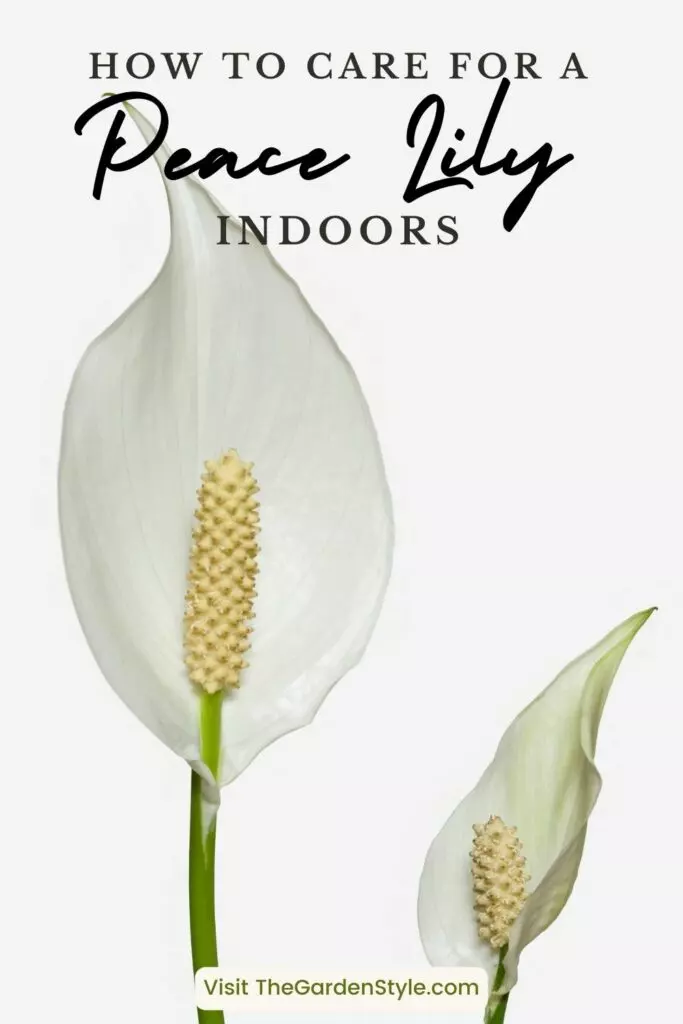As a plant enthusiast, I have found that peace lilies are one of the easiest indoor plants to care for. They are not only beautiful but also have air-purifying qualities. In this post, I will share with you my knowledge and experience on how to care for a peace lily indoors.
Table of Contents
How to Care for a Peace Lily Indoors
To start, it is important to understand that peace lilies are tropical plants and thrive in warm and humid environments. They require indirect sunlight and should not be exposed to direct sunlight, as it can damage their leaves. If you are living in a dry climate, you may need to mist the plant regularly to increase the humidity around it.
When it comes to watering, peace lilies prefer moist soil but can be sensitive to overwatering. It is essential to let the soil dry out slightly between waterings and to avoid leaving the plant in standing water.
In addition to watering, peace lilies benefit from occasional fertilization. Apply a balanced houseplant fertilizer just once per month while the peace lily is actively growing to nourish healthy development. However, use caution not to over-feed as excess fertilization can be harmful to peace lilies.
| Care Tips | Details |
| How Much Light Does a Peace Lily Need | Peace lilies prefer bright, indirect light. |
| Watering Needs | Water once a week or when the top inch of soil feels dry to the touch. |
| Ideal Temperature and Humidity | Prefer temperatures between 65-80°F (18-27°C) and high humidity levels. |
| Fertilization and Soil | Monthly application of a balanced, water-soluble fertilizer during the growing season. |
| Propagating New Plants from Cuttings | Take a cutting that is at least 6 inches (15 cm) long and has at least two leaves. |
| Repotting Root-Bound Plants | Gently remove it from its pot and loosen the roots. |
In summary, peace lilies are low-maintenance indoor plants that can add beauty and purify the air in your home. With proper care, they can thrive and continue to bring joy to your space.
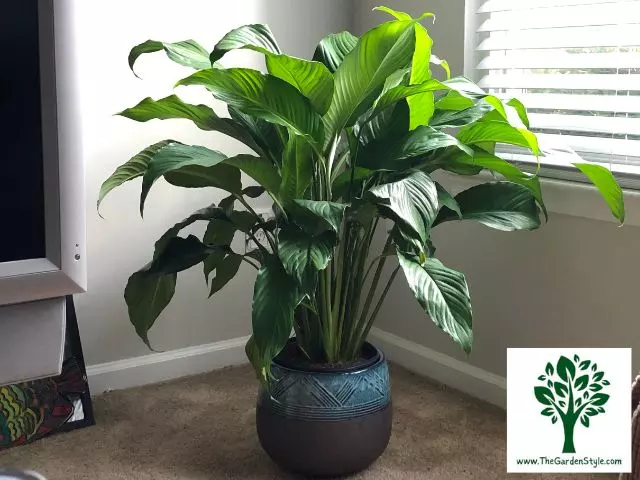
How Much Light Does a Peace Lily Need?
Peace lilies prefer bright, indirect light. They can tolerate low light, but this will slow their growth and reduce the frequency of flowering. Direct sunlight can scorch the leaves. It is best to keep them near a window that receives filtered or indirect light. To properly care for a peace lily indoors, ensure it receives filtered, indirect sunlight. If you notice that the leaves are turning yellow, it may be a sign that the plant is receiving too much light.
Watering Needs
To care for a peace lily indoors, maintain consistently moist soil without overwatering. Providing too much moisture to the roots can cause root rot disease, which is often lethal for peace lilies. It is best to water them once a week or when the top inch of soil feels dry to the touch.
When watering, pour water slowly over the soil until it starts to drain out of the bottom of the pot. Remove any water remaining in the drainage saucer after watering your peace lily. Allowing the plant to sit in excess water can lead to root rot over time.
In the table below, I have summarized the watering needs of a peace lily to help you keep track of its care.
| Watering Needs | Frequency |
| Watering | Once a week |
| Soil Moisture | Slightly moist |
| Watering Amount | Enough to saturate the soil |
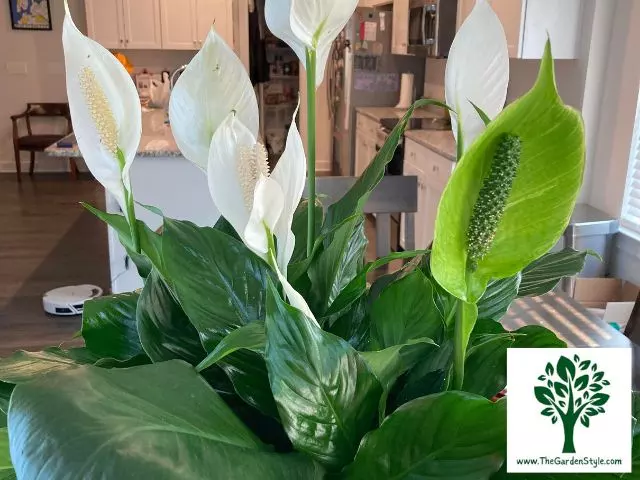
Ideal Temperature and Humidity
Peace lilies prefer temperatures between 65-80°F (18-27°C). They can tolerate temperatures outside of this range, but they may not thrive. They also prefer high humidity levels, so it is a good idea to mist them regularly or place them near a humidifier. If the surrounding air lacks adequate moisture, the foliage of the peace lily will often become desiccated and brown along the edges. Providing proper humidity levels is crucial when you care for a peace lily indoors.
Fertilization and Soil
Peace lilies do not require a lot of fertilizer. Still, they will benefit from a monthly application of a balanced, water-soluble fertilizer during the growing season. Ensure the peace lily is planted in an ideal soil blend that effectively permits drainage yet also retains some moisture – high in organic substances like peat moss or compost. Avoid using heavy soils that retain too much moisture, as this can lead to root rot.
If you want to learn what type of potting mix is ideal for healthy peace lily growth, be sure to read my post on the best soil for peace lily.
Propagating New Plants from Cuttings
Peace lilies can be propagated from stem cuttings. To do this, take a cutting that is at least 6 inches (15 cm) long and has at least two leaves. After cutting the peace lily stem, coat the severed base in a rooting enzyme solution. Next, plant the cutting into a container filled with damp potting mix. Maintain consistent moisture in the soil medium. Lastly, situate the propagation pot in an area with ample warmth and indirect light. The cutting should root in a few weeks.
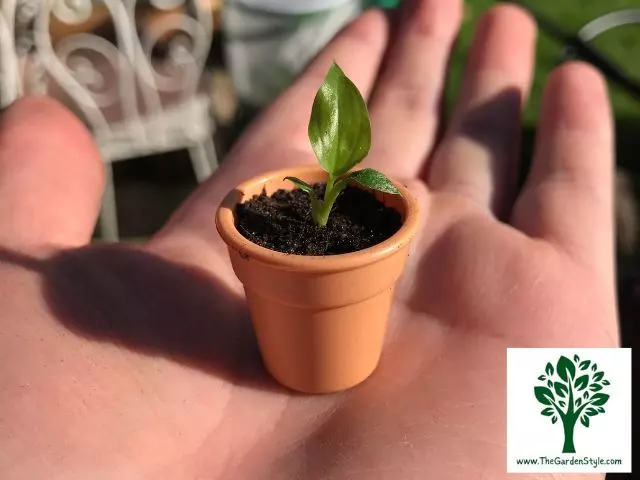
Repotting Root-Bound Plants
Peace lilies can become root-bound over time, which can lead to stunted growth and poor health.
To repot a root-bound plant, gently remove it from its pot and loosen the roots. Place it in a new pot that is one size larger and fill in the gaps with fresh potting soil. Water the peace lily thoroughly and place it in a bright, indirect location.

Common Problems and Solutions
Brown Tips
One of the most common problems with peace lilies is brown tips on the leaves. Multiple issues can trigger brown tips on a peace lily, including both excessive and insufficient irrigation, as well as too much intense sun exposure.
To fix it, make sure you are watering your plant properly and providing it with the right amount of light. Trim off any brown tips with a sharp pair of scissors.
If you’re dealing with annoying brown tips on your peace lily leaves, I highly recommend reading my post on how to treat and prevent brown tips on peace lilies.
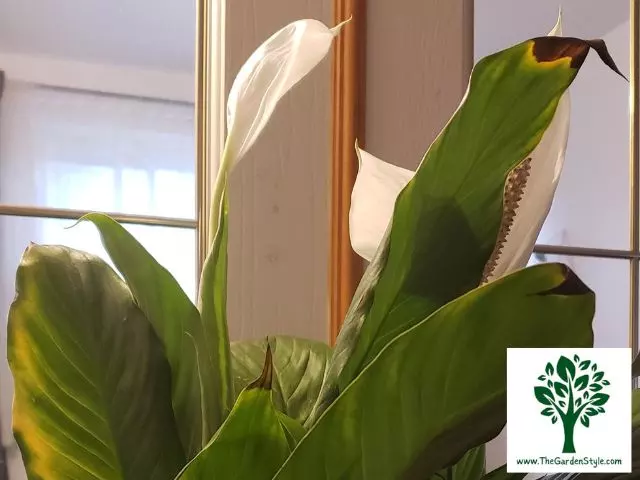
Leaves Turning Yellow
Yellowing leaves on a peace lily can be a sign of overwatering, underwatering, or too much direct sunlight.
To fix it, make sure you are watering your plant properly and providing it with the right amount of light. If the soil is waterlogged, let it dry out before watering again. Remove any yellow leaves to prevent the problem from spreading.
If your peace lily leaves are turning yellow and you want to get to the bottom of the issue, check out our informative post all about the causes of peace lily yellow leaves and what to do about them.
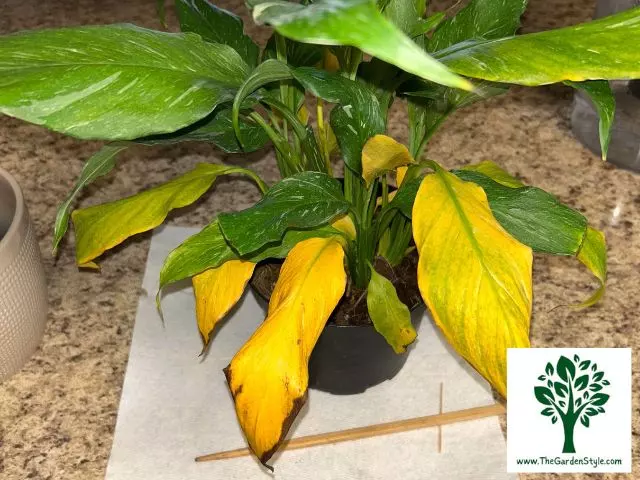
Wilting
If your peace lily is wilting, it could be a sign of underwatering or overwatering. Check the soil moisture level and adjust your watering schedule accordingly.
If the soil is waterlogged, let it dry out before watering again. If the soil is dry, water the plant thoroughly and make sure it is draining properly.
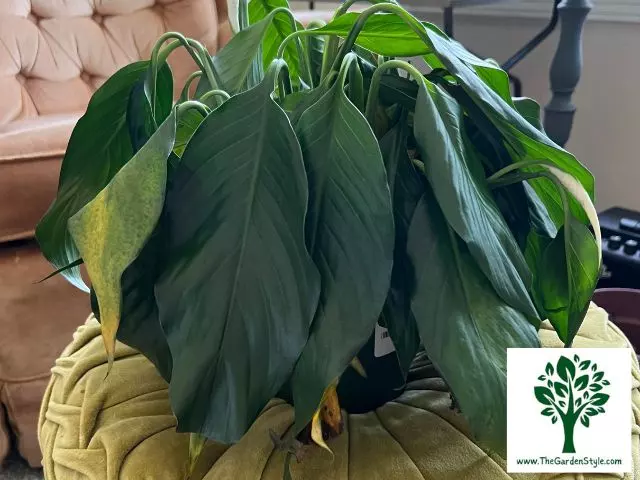
Peace Lily Not Flowering
If your peace lily isn’t blooming, it could be due to a lack of light or nutrients. Make sure the plant is getting enough indirect sunlight and fertilize it regularly with a balanced fertilizer. It’s also important to keep the plant in a warm, humid environment. For more information, I recommend you to read our article on how to get peace lily to bloom.
Drooping Leaves
Drooping leaves on a peace lily can be a sign of underwatering or overwatering. Examine the potting mix moisture content and make suitable corrections to how often you water the peace lily.
If the soil is waterlogged, let it dry out before watering again. If the soil is dry, water the plant thoroughly and make sure it is draining correctly.
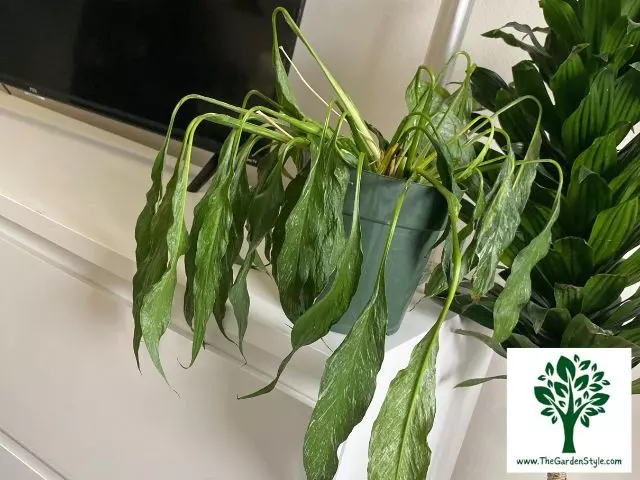
Damaged Foliage
If your peace lily’s foliage is damaged, it could be due to pests or disease. Inspect the plant for any signs of pests, such as spider mites or mealybugs, and treat accordingly. If the plant has a disease, remove the affected foliage and treat with a fungicide.
| Common Problems | Causes | Solutions |
| Brown Tips | Overwatering, Underwatering, or Too Much Direct Sunlight | Water Properly, Provide Right Amount of Light, Trim Brown Tips |
| Leaves Turning Yellow | Overwatering, Underwatering, or Too Much Direct Sunlight | Water Properly, Provide Right Amount of Light, Remove Yellow Leaves |
| Wilting | Underwatering or Overwatering | Check Soil Moisture, Adjust Watering Schedule, Ensure Proper Drainage |
| Peace Lily Not Flowering | Lack of Light or Nutrients | Provide Indirect Sunlight, Fertilize Regularly, Keep in Warm, Humid Environment |
| Drooping Leaves | Underwatering or Overwatering | Check Soil Moisture, Adjust Watering Schedule, Ensure Proper Drainage |
| Damaged Foliage | Pests or Disease | Inspect for Pests, Treat Accordingly, Remove Affected Foliage, Treat with Fungicide |
Are Peace Lily Plants Poisonous for Pets?
Yes, peace lily plants are poisonous to dogs and cats if ingested. Some key points about peace lilies and pets:
- All parts of the peace lily contain calcium oxalate crystals, which are toxic to dogs and cats if eaten. This includes the leaves, flowers, stems and even the water in the plant’s vase.
- Eating even a small part of a peace lily can cause drooling, swelling/irritation in the mouth and tongue, vomiting, and difficulty swallowing in animals.
- Larger ingestions of a peace lily plant can cause more severe signs like diarrhea, lethargy, and tremors, and may require veterinary treatment. In rare cases it has led to fatal kidney or liver damage.
- Pet owners should keep peace lily plants well out of reach from dogs and cats to prevent any chance they may nibble on the leaves or flowers out of curiosity.
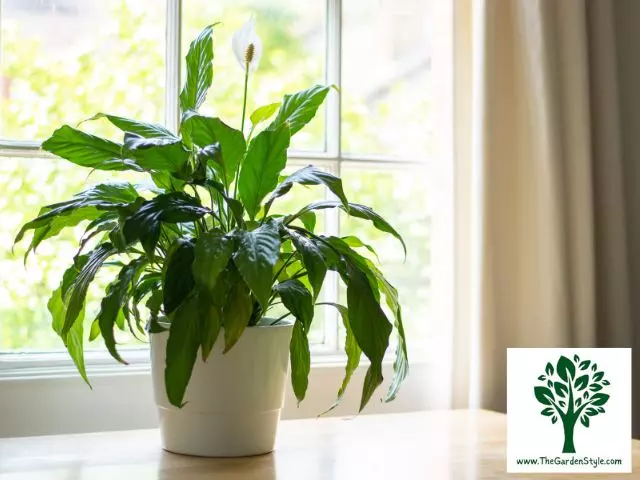
Indoor Peace Lily Care: A Quick Recap
In this article, I have shared some tips on how to care for your peace lily indoors. By following these guidelines, you can ensure that your plant stays healthy and vibrant.
As a quick summary, here are the key points to remember:
| Caring Category | Details for a Peace Lily Indoors |
| Light Needs | Peace lilies prefer bright, indirect light. |
| Watering Needs | Water your peace lily when the top inch of soil is dry. |
| Humidity Preferences | Peace lilies thrive in high humidity, so misting or placing them near a humidifier can help. |
| Fertilizer Application | Fertilize your peace lily every 2-3 months during the growing season. |
| Repotting Frequency | Repot your peace lily every 1-2 years to ensure it has enough space to grow. |
| Addressing Common Problems | Yellow leaves, brown tips, and root rot are common issues that can be addressed with proper care. |
Remember to always keep an eye on your peace lily and adjust your care routine as needed. With a little attention and care, your peace lily can thrive and bring beauty to your indoor space.
If this post about how to care for a peace lily indoors was helpful, please share it:

